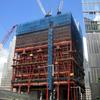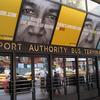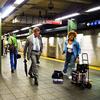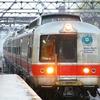Jim O'Grady appears in the following:
Christie Weighs Toll And Fare Hikes, Says Alternative in Works
Wednesday, August 17, 2011

New Jersey Governor Chris Christie told reporters Thursday that he and New York Governor Andrew Cuomo were working on a coordinated alternative to the Port Authority's proposed toll and fare hike, but did not know if their alternative would be announced in time for the Port Authority board meeting on Friday.
Opinion: Does a 'Rascally' Rick Perry Have Bill Clinton Worried?
Wednesday, August 17, 2011
I had a flashback on Tuesday when President Bill Clinton gave a speech to a group of firemen in Midtown Manhattan and called Gov. Rick Perry of Texas a “good-looking rascal” whose anti-government platform was “crazy.”
That rhetorical sleight of hand—raising an alarm about Perry’s potential attraction to voters while simultaneously smack-talking him--reminded me of a conversation I had in mid-2001 with a Clinton staffer.
NY-NJ Port Authority's Proposed Toll and Fare Hikes: Behind the Numbers
Wednesday, August 17, 2011
1 World Trade Center, a Port Authority project, under construction. (Photo by wallyg / flickr)
(New York, NY - WNYC) Three big numbers are at the heart of the hefty toll and fare hikes proposed by the Port Authority of New York and New Jersey:
- $33 billion for a 10-year capital plan.
- $11 billion to rebuild the World Trade Center.
- $6 billion for increased security since the September 11 attacks.
And they all have one thing in common: they pay for construction jobs. That explains why unionized plumbers, carpenters and iron-workers packed a public hearing Tuesday at the Port Authority Bus Terminal to speak in favor of the hikes.
Chris Colombia, a union contractor, said the extra money collected would pay for 185,000 jobs — that's more than the 167,000 jobs the authority claims will be created. But the point, repeated by more than a dozen union members, was the same: "priming the pump" of the local construction industry will be good for the economy.
Predictably, drivers saw the issue differently.
"I understand the need for jobs but let me tell you something," said driver Jason Ertell. "The Port Authority facilitates commerce across the river between these two states — trillions of dollars in every sort of business and every sector that you can imagine in this economy."
Toll and fare hikes, he went on, raises the cost of doing business in New York and New Jersey and that kills jobs.
Both Governors Andrew Cuomo and Chris Christie professed initial shock at the notion of non-EZ Pass drivers paying as much as $15 for a round-trip during peak hours and PATH riders absorbing a $1 increase to their fare.
Still, Cuomo said, he understood the Port needed money, and that he would huddle with his appointees on the board to review the proposal.
“The knee-jerk response of, ‘The government needs more money, go to the taxpayer, put your hand in the taxpayers' pocket, take out more money and fund it,'" Cuomo said. "That doesn’t work for me."
But he has not ruled out the hikes. The Port Authority estimates they'd raise $720 million a year and an additional $290 million a year after 2014, when tolls would rise again.
Port Authority executive director Chris Ward has issued a statement that seems aimed at convincing both governors to approve the full increases.
"We recognize that the propose increase is substantial," the statement said. "But it is also absolutely necessary to ensure the financial strength of the Port Authority and to maintain and grow the critical transportation infrastructure that serves the bi-state region."
A similar rationale was given in prefatory remarks by the Port Authority employee overseeing Tuesday morning's public hearing at the bus terminal.
But it didn't convince driver Andrew Holloway, who began his testimony this way: "Hi, ladies and gentlemen. I think we all know somewhere that this proposed increase is insane."
Port Authority's Proposed Toll and Fare Hikes: Behind the Numbers
Tuesday, August 16, 2011

Three big numbers are at the heart of the toll and fare hikes proposed by the Port Authority of New York and New Jersey, and they all have one thing in common: they pay for construction jobs.
Opinion Split At Public Hearing On Steep NY-NJ Port Authority Toll And Fare Hikes
Tuesday, August 16, 2011
(Photo by meh8335 / Flickr)
(New York, NY - WNYC) The public is having its say today about steep toll and fare hikes proposed by the Port Authority of New York and New Jersey. At a public hearing this morning held at the Port Authority Bus Terminal on 42nd Street in Manhattan, drivers and PATH Train riders passionately panned the looming increases. But trade unionists, which stand to benefit if more money goes towards the agency's capital projects, approved of increasing revenues through hikes.
Jason Ertrell is a lawyer who drives over the George Washington Bridge every day from Clifton, NJ, to Midtown. He showed up at the hearing, signed in and took the podium to say he's not happy with what he gets for what he pays. "What I don't understand is how every morning as I drive down to pay my eight dollars, my fillings are getting rattled out and the shocks to my car are getting beat to hell--beat to heck, excuse me."
The NY-NJ Port Authority wants to raise those tolls even higher--up to $12 for EZ Pass users, and up to $15 for drivers who pay cash during peak periods. PATH Train riders would see the base price of a trip increased from $1.75 to $2.75.
But most of the 100 people at the hearing, like laborer Ramon Woodcock, were pro-hike construction workers. "The rebuilding of the World Trade Center is currently a priority and must remain so," said Woodcock. "It is a matter of American pride."
The rebuilding of the World Trade Center is a NY-NJ Port Authority project. Its current price tag is $11 billion.
Governors Cuomo and Christie, who control appointments to the authority's Board of Commissioners, initially balked at the hikes. It's now widely assumed that they're talking to the NY-NJ Port Authority about lowering them. (The commissioners are scheduled to vote on the hikes on Friday.) Those negotiations could be heating up: yesterday Port Authority executive director Chris Ward issued a strongly-worded statement defended the increases it has asked for.
"We recognize that the proposed increase is substantial," the statement said. "But it is also absolutely necessary to ensure the financial strength of the Port Authority and to maintain and grow the critical transportation infrastructure that serves the bi-state region."
A similar rationale was given in prefatory remarks by the NY-NJ Port Authority employee overseeing this morning's public hearing at the bus terminal. It didn't convince driver Andrew Holloway, who began his testimony this way: "Hi, ladies and gentlemen. I think we all know somewhere that this proposed increase is insane."
Riders, Drivers Will Get To Sound Off On Proposed NY-NJ Port Authority Toll Hikes
Monday, August 15, 2011
The George Washington Bridge, a NY-NJ Port Authority Crossing. (Photo by wally g / Flickr)
(New York, NY - WNYC) The New York-New Jersey Port Authority will hold public hearings tomorrow on a proposal for steep toll and fare hikes that could take effect as soon as next month. The increases were announced ten days ago, with a vote by the authority's Board of Commissioners scheduled for August 19. But first, riders and drivers will have a chance to express their feelings about PATH trains costing a dollar more per ride and Hudson River bridges and tunnels going up to 15 dollars per round-trip.
New York Governor Andrew Cuomo and New Jersey Governor Chris Christie call the proposed hikes "indiscriminate and exorbitant," though it's an open question about whether they will accept a scaled-down version. (A New York Times editorial was hardly alone in characterizing the initial remarks as "gubernatorial theatrics.")
Neither governor is ruling out the toll hikes altogether.
Other editorial writers have labeled them "grotesque" and "a heavy burden." And Automobile Association of America spokesman Ron Sinclair told TN that, "Our members are contacting us and telling us it’s very unfair, it's outrageous, it's a burden that's going to be tough to bear during a difficult economy."
But labor unions, and business and trade organizations, say the hikes are needed to keep the port and airports running, bridges standing and progress moving on a rebuilt World Trade Center.
The Port Authority says they're needed because it's been hit with a triple-whammy: a recession that has caused lower volumes of toll-paying traffic on its crossings to the tune of $2.6 billion; post-9/11 security costs that have driven up the budget of the World Trade Center rebuilding; and "the need for the largest overhaul of facilities in the agency’s 90-year history."
(Go here for the authority's justification of the hikes. And here for Andrea Bernstein's analysis of the politics behind it.)
Tomorrow, the authority will host hearings in New York and New Jersey to learn whether their customers think that's worth the increased tolls and fares they may soon be required to pay.
Here is the Port Authority's August 16 public hearing schedule:
Newark Liberty International Airport
1 Conrad Road
Building 157, Bay 3
Newark, NJ 07114
973-961-6161
8 a.m.
Port Authority Technical Center
241 Erie Street, Room 212
Jersey City, NJ 07310
201-216-2700
8 a.m.
Port Ivory/Howland Hook
40 Western Ave.
Staten Island, NY 10303
718-330-2950
8 a.m.
Port Authority Bus Terminal
625 8th Avenue
Times Square Conference Room – 2nd Floor
New York, NY 10018
212-502-2240
8 a.m.
George Washington Bridge Administration Building
220 Bruce Reynolds Way
Conference Room
Fort Lee, NJ 07024
201-346-4005
6 p.m.
Holland Tunnel Administration Building,
13th Street & Provost Street
Conference Room
Jersey City, NJ 07310
201-360-5021
6 p.m.
George Washington Bridge Bus Station
4211 Broadway
Lower Level Conference Room
New York, NY 10033
201-346-4005
6 p.m.
John F. Kennedy International Airport
Port Authority Administration
Building 14, 2nd Floor Conference Room
Jamaica, NY 11430
718-244-3501
6 p.m.
Public Weighs in at Port Authority Hearings on Proposed Toll Hikes
Monday, August 15, 2011

Opinions have been mixed during public hearings held by the Port Authority throughout the area on the proposed fare hikes that could cost drivers $15 round trip to cross bridges and tunnels and $1 more to ride the PATH.
Derailment Sparks Fierce Debate Over Future Of Rail Between NY And NJ
Friday, August 12, 2011
(robotbrainz/Flickr)
(New York, NY - WNYC) For three rush hours over two days this week, the derailed New Jersey Transit train cars sat motionless as roadkill. They'd broken down not far from their point of departure, Penn Station in Manhattan, and were blocking a section of track outside one of two heavily used train tunnels beneath the Hudson River. With one slip off the rails, they'd reduced by half the rail capacity between New Jersey and the central business district of New York--a crucial commuter link that accommodates 1,300 trains a day. Massive delays ensued.
The longer the crippled cars idled, the lower two powerful New Jersey politicians swooped, looking to make a meal of the situation.
U.S. Senator Frank Lautenberg issued a statement that essentially said, this is why New Jersey Governor Chris Christie should never have canceled the ARC Tunnel last fall. The project would have doubled the train lines under the Hudson from two to four. With an ARC Tunnel, a derailment blocking one track would leave three tracks running.
"The existing tunnel is over a century old and not capable of handling the increased traffic we will see in the future," Lautenberg said. "Instead of accepting $3 billion in federal funding for New Jersey to advance the ARC project, the Governor turned down the money and settled for the status quo – leaving New Jersey commuters and our economy to suffer."
In an email to WNYC, Christie press secretary Michael Drewniak called Lautenberg's remarks "completely gratuitous." He said the ARC Tunnel threatened cost overruns that New Jersey couldn't afford.
"The senator of all people should know by now that the tunnel project he continues to endorse was stopped because it was a very bad deal for New Jersey," Drewniak wrote, before adding that the governor supported "additional cross-Hudson commuter rail capacity."
As it happens, there's a plan for that. It's called Gateway Tunnel. (See this pdf). Senator Lautenberg is a champion of the project, though he much preferred the ARC tunnel, which would've added 25 trains per hour compared to Gateway's 21. It was also already under construction, mostly funded, and scheduled to open by decade's end.
New Jersey's monetary contribution to the ARC project, which Christie believed was too high, would've meant that New Jersey Transit controlled it--as opposed to control by Amtrak, which already owns and oversees the existing tunnel.
The importance of that arrangement was shown by the recent derailment. Amtrak was in charge of dispatching trains along the sole serviceable track. It's unclear whether Amtrak privileged its dozens of rush hour trains compared to NJ Transit's hundreds, but for the most part Amtrak suffered delays of 15 to 45 minutes while NJ Transit saw massive cancellations and long delays. (It was a bilevel NJ Transit train that derailed. Neither Amtrak nor NJ Transit has cited a cause for the accident.)
Supporters of the Gateway Tunnel say it will cost $10 to $13 billion and ten years to complete. What are the chances it will happen? Next month will provide a clue, when Amtrak's request for $50 million for a design study comes before Congress. A staff member to an elected official familiar with the request said he expects a fierce fight over it, with cost-conscious Republicans in the House opposing and Democrats supporting it.
UPDATE. The Business Alliance for Northeast Mobility says in a blog post that when one of two train tunnels is blocked, capacity is actually cut by more than 50 percent:
When trains go through a single tunnel in one direction, they can follow each other one after the other with minimal space in between. But if a single tunnel serves trains going in both directions, the trains must be more spaced out, because a train going in one direction must wait for the train in the opposite direction to clear the tunnel. So, for example, two tunnels each serving 25 trains per hour, becomes one tunnel serving 15.
Cuomo Forms Committee to Search for Next MTA Chief
Monday, August 08, 2011
Governor Andrew Cuomo has announced a search committee to find a replacement for outgoing Metropolitan Transportation Authority chairman Jay Walder, who abruptly announced his resignation last month.
Wanted: Someone Brave--Foolhardy?--Enough To Lead the NY MTA
Monday, August 08, 2011

(New York, NY - WNYC) New York Governor Cuomo moments ago announced a search committee (full release at end of post) to find a replacement for outgoing NY Metropolitan Transportation Authority chairman Jay Walder, who abruptly announced his resignation last month. On October 21, Walder will forsake what has been America's plummest transit job to become CEO of MTR Corporation, a deep-pocketed private rail company in Hong Kong.
Among those asked to sift resumes and conduct interviews as members of the committee are former Deputy U.S. Transportation Secretary Mortimer Downey, Former Lt. Governor Richard Ravitch, and MTA watchdogs Gene Russianoff of The Straphangers Campaign and Bob Yaro, president of the Regional Plan Association.
The group has a much wider span than Cuomo's transportation transition committee, which had no planners or transit advocates among its membership.
If the past is a guide, Cuomo will choose the next chair of the nation's largest transit system from one of two broad categories: a politically connected ally or campaign donor, like his choice to head the New York Thruway Authority; or a high-profile transportation professional in the mold of Walder and his predecessor, Eliot Sander.
Cuomo has spoken sparingly about transportation policy--his first months in office were marked by other priorities, like tax cuts, an on-time budget, and gay marriage--so it is difficult to divine his leanings on who'll get to helm the NY MTA through the storms ahead. (For a laugh-until-you-cry take on the near-apocalyptic forces arrayed against the authority, read this fake job posting that seeks a "politically savvy transit manager willing to preside over the gradual re-collapse of New York City's transit system...")
But transit watchers have noted with interest that the governor, in putting together his search committee, has reached out beyond government officials and other usual suspects.
The new chairperson will face a bewildering array of challenges as soon as he or she slides into the $350,000 a year position. The 2012-2015 capital construction plan has a $9 billion dollar shortfall; a crucial labor negotiation looms with the Transit Workers Union, which has already declared that the authority's plan to win a three-year contract with no wage increases is dead-on-arrival; and yet another fare increase is scheduled for next year--and two years after that. In addition, a faction of the state legislature is on the warpath against a mobility tax instituted in 2009 to shore up the NY MTA budget. The authority's chief financial officer has warned that repealing the tax, as Senate Republicans are angling to do, will collapse the NY MTA's already shaky fiscal stability.
"Jay Walder made great strides," said one transit advocate. "He improved the credibility of the MTA with the public and the state legislature. He found more cost efficiencies than in many years. But he's still winning over the public. That’s not something that’s going to be done in two years after thirty years of disappointing and infuriating the public."
And it will soon no longer be his headache, but someone else's.
Here's the full press release from Governor Cuomo:
GOVERNOR CUOMO ANNOUNCES MTA SEARCH ADVISORY COMMITTEE
Committee will assist with search for new MTA chairman
Governor Andrew M. Cuomo today announced the creation of an MTA Search Advisory Committee that will assist in recommending and evaluating candidates for the next chairman and CEO of the Metropolitan Transportation Authority.
"This committee will help conduct a national and international search to find and recommend the most talented candidates for the next chairman of the MTA," Governor Cuomo said. "I am committed to appointing a new chairman who will put straphangers first and who will continue to reform the MTA by reducing costs and waste, while improving efficiency and service."
The advisory committee is comprised of leading public transportation experts and management professionals in the public and private sectors. An executive search and recruitment firm, Krauthamer & Associates, has been engaged to assist in the process. The Governor's appointment of an MTA chairman is subject to Senate confirmation.
Mortimer Downey, former Deputy Secretary of U.S. Department of Transportation, said, "This committee will assist with a comprehensive review and evaluation process of top-tier professionals to be considered for next chairman of the MTA. With tight budget pressures and hard decisions ahead, the new chairman must ensure the MTA provides quality service while meeting tough fiscal demands. Governor Cuomo's strong commitment to the MTA is reflected in this committee's membership of experienced civic leaders and public transportation experts."
Gene Russianoff, Senior Attorney of the NYPIRG Straphangers Campaign, said, "The next chairman and CEO of the MTA will shape transportation policies in the New York metropolitan region for millions of daily riders, and I congratulate the Governor for putting together a great panel to seek the best possible candidates."
Robert Yaro, President of the Regional Plan Association, said, "Governor Cuomo has charged this committee with assisting in the selection of a new chairman for the MTA and over the next months we will help evaluate and review top public transportation professionals from across the nation. I commend the Governor for assembling this committee to assist with finding a new chairman, and I look forward to continuing to work together to revitalize our state's public transportation system."
Members of the Committee include:
Vincent Alvarez, President, New York City Central Labor Council
Mr. Alvarez is President of the New York City Central Labor Council, an organization that represents more than one million union members. Mr. Alvarez is the council's first Hispanic and first full-time president. He previously served as deputy legislative director of the New York State A.F.L-C.I.O, and was former Chief of Staff at the Council.
Lillian Borrone, Board Chair, Eno Transportation Foundation
Ms. Borrone currently chairs the Eno Transportation Foundation, a nonprofit organization that partners with government agencies, professional and private organizations to improve the mobility, safety and sustainability of transportation systems. Ms. Borrone previously served as the Assistant Executive Director of the Port Authority of NY and NJ, and also held positions as the Director of the Port Commerce Department and Director of Management and Budget.
Stanley Brezenoff, President and CEO, Continuum Health Partners
Mr. Brezenoff currently serves as the President and CEO of Continuum Health Partners, a hospital system that includes Beth Israel Medical Center, St. Luke's-Roosevelt Hospital Center, Long Island College Hospital and The New York Eye and Ear Infirmary. Previously, he served as the Executive Director of the Port Authority of NY and NJ, and was the former Deputy Mayor of Operations, as well as the First Deputy Mayor of New York City, during the Koch administration.
Mary Ann Crotty, Former Director of State Operations
Ms. Crotty is the former Deputy Secretary for Transportation and former Director of State Operations under Governor Mario Cuomo.
Beverly Dolinsky, Former Executive Director, Permanent Citizens Advisory Committee
Ms. Dolinsky formerly served as the Executive Director Permanent Citizens Advisory Committee to the MTA for 25 years. Ms. Dolinksy also was the first riders' representative on the MTA board, a non-voting seat that was established in 1995, where she served for 8 years.
Mortimer Downey, Former Deputy Secretary, US Department of Transportation
Mr. Downey formerly served as the Deputy Secretary at US Department of Transportation during the Clinton Administration. He is currently Secretary of the Eno Transportation Foundation and a Senior Advisor for Parsons Brinckerhoff. He began his career at the Port Authority of NY and NJ, where he held various positions. Mr. Downey has also served as the Executive Director and Chief Financial Officer of the New York MTA.
Fernando Ferrer, Board Member, MTA
Mr. Ferrer formerly served as Bronx Borough President from 1987 to 2001. Upon leaving this post, he ran for mayor of New York in both 2001 and 2005. He is the former director of the Drum Hill Institute, and is a current co-chairman of Mercury Public Affairs.
Howard Glaser, Director of State Operations
Sidney Holmes, Partner, Winston Strawn LLP
Mr. Holmes is a corporate partner at Winston Strawn LLP, and has served as bond counsel, underwriter's counsel, and bank counsel in virtually every type of municipal bond financing throughout the United States and its territories. In May 2008, Mr. Holmes was appointed by New York Governor David Paterson to serve as a commissioner of the Port Authority of NY and NJ. Mr. Holmes is also a commissioner of the New York State Insurance Fund and is a board member of the New York Urban League, and the Brooklyn Navy Yard Development Corporation.
Denis Hughes, President, New York State AFL-CIO
Mr. Hughes is the current president of the 2.5 million-member New York State AFL-CIO. He first became a union member at the age of 16 when he joined the Retail Clerks Union, and later joined the AFL-CIO as Political Director and Assistant to the President. He was first elected as President in 1999, and was subsequently re-elected to three consecutive terms. Mr. Hughes has also served as Commissioner of the New York State Insurance Fund, and was appointed to the Board of Directors of the Federal Reserve Bank of New York.
William Longhi, President & CEO, Orange and Rockland Utilities, Inc.
Mr. Longhi has been the President and Chief Executive Officer of Orange and Rockland Utilities, Inc. since February 2009. Previously, he served as Senior Vice President of Central Operations at Con Edison Company of New York. Since joining Con Edison in 1976, Mr. Longhi has held a variety of positions throughout the company, including Vice President of Operations at O&R in 2000 and 2001.
Mitchell Moss, Director, Rudin Center for Transportation Policy and Management
Prior to his appointment as Director of the Rudin Center for Transportation Policy and Management, Mr. Moss was the Director of NYU's Taub Urban Research Center, where he directed research projects for the National Science Foundation, Charles Revson Foundation, U.S. Department of Commerce, New York State Economic Development Corporation, and leading private corporations. Professor Moss has been on the faculty of NYU since 1973.
Richard Ravitch, Former Lieutenant Governor of New York
Mr. Ravitch is a veteran public servant, having worked in both federal and state government for decades. In the late 1960s, Ravitch left his family's construction firm to join President Lyndon Johnson's administration. Under President Johnson, Ravitch served as a member of the United States Commission on Urban Problems and was elected president of the Citizens Housing and Planning Council. Later, under Governor Hugh Carey, Mr. Ravitch served as chairman of the New York State Urban Development Corporation, rescuing the agency from near-bankruptcy. Mr. Ravitch went onto become chairman of the Metropolitan Transportation Authority. In 2008, Governor Paterson tapped him to chair a commission charged with restoring the MTA to sound financial footing and he subsequently served as Lieutenant Governor. Currently Mr. Ravitch is a partner at New York based law firm Ravitch, Rice & Co.
Bill Rudin, Chairman, Association for a Better NY
In addition to serving as the Chair of the Association for a Better NY, Mr. Rudin is currently the President of Rudin Management Company, Inc. He also serves as Chairman of the Board for the Battery Conservancy and as a member of the Boards of the Metropolitan Museum of Art, the Real Estate Board of New York and New York University.
Gene Russianoff, Senior Attorney, NYPIRG Straphangers Campaign
Mr. Russianoff is senior attorney and chief spokesman for the Straphangers Campaign for NYPIRG, a Manhattan-based public transportation advocacy group that focuses mainly on subway and bus services run by New York City Transit. Mr. Russianoff has worked for NYPIRG since his graduation from Harvard Law School in 1978.
Desmond Ryan, Executive Director, Association for a Better Long Island
Mr. Ryan is the Executive Director at ALBI. Previously, Mr. Ryan worked at Grumman Aerospace where he worked in public affairs issues in both Washington, D.C. and Albany. He has also served as Director of Government Affairs at the Long Island Association, and worked in the Office of the New York State Assembly Speaker in the 1980s where he focused on legislative issues affecting the Long Island region.
Thomas Schwarz, President, SUNY Purchase
Mr. Schwarz has served as President of SUNY Purchase since 2003. He is a retired partner from Skadden, Arps, Meagher and Flom, which he originally joined in 1969. At Skadden, he was National Practice Leader of the Litigation Department and the founding partner of the firm's Committee on Diversity. Mr. Schwarz served as mayor of the village of Ocean Beach in Suffolk County from 1978 to 1987 and was Special Counsel to the New York State Commission on Government Integrity 1987-1991. He also served as acting president of Hamilton College in 1999.
Rodney Slater, Partner, Patton Boggs
Mr. Slater is a partner at Patton Boggs. Previously, Mr. Slater served as Secretary of the US Department of Transportation during the Clinton Administration. He also served as director of the Federal Highway Administration. He is also a partner at James Lee Witt Associates and currently serves on the board of directors of Africare and The Dance Theater of Harlem. He is the chair of the Board of Trustees of United Way and serves on the corporate boards of Delta Air Lines and Verizon.
Robert Steel, Deputy Mayor for Economic Development
Robert K. Steel is currently the Deputy Mayor for Economic Development. He is responsible for the city's five-borough economic development strategy and job-creation efforts, and spearheads major development projects city-wide. Deputy Mayor Steel oversees various agencies including the Department of Housing Preservation and Development, Department of City Planning, Department of Small Business Services, NYC Economic Development Corporation and NYC & Company. Previously, Mr. Steel was the President and CEO of Wachovia. He also formerly served as Under Secretary for Domestic Finance at the U.S. Department of the Treasury. Prior to entering government service, Mr. Steel spent nearly three decades at Goldman Sachs, where he became co-head of the U.S. Equities Division and Vice Chairman of the firm.
Robert Yaro, President, Regional Plan Association
Mr. Yaro is currently President of Regional Plan Association, the nation's oldest independent metropolitan policy, research, and advocacy group. Mr. Yaro also co-chairs the Empire State Transportation Alliance and the Friends of Moynihan Station, and is Vice President of the Forum for Urban Design.
After FAA Shutdown, Resumption Of Airport Construction Won't Happen Overnight
Thursday, August 04, 2011
Runway reconstruction at Sea-Tac Airport in Seattle. (Photo by Michael @ NW Lens / Flickr)
(New York, NY - WNYC) About 74,000 transportation and construction workers are looking forward to getting back to work on more than 250 airport construction projects now that Congress has agreed to re-authorize the Federal Aviation Administration.
A spokesperson for the U.S. Department of Transportation said in an email that, "FAA employees can go back to work the day after the law is signed by President Obama. If the bill is passed by the Senate and signed by the President [on Friday], that would be Monday."
But FAA engineer Dan Stepko warns many of those projects have lost more than the two weeks during which workers were furloughed while Congress wrangled over the agency's temporary re-authorization.
"There's going to be a lot of carnage in the wake of this shutdown," he said. "Projects don't just start and stop, especially projects that are in the tens of millions of dollars. If you're down for a week, it's going to take two to three weeks to get going again. Construction equipment has to be rented again, workers have to be rehired in a lot of cases."
Secretary of Transportation Ray LaHood, appearing on Hardball with Chris Matthews, also lamented the loss of time "smack dab in the middle of the construction season." He said construction workers count on employment during the summer to make it through bad-weather seasons when fewer jobs are available. "This is their bread and butter," he said. "This is when they make their money."
Despite the sigh of relief breathed by Stepko, LaHood and the entire U.S. aviation industry, Congress must vote to re-authorize the FAA again when it reconvenes next month.
You heard right. In six weeks or so, the wrangling starts again.
US DOT Says Deal Reached to Re-open FAA
Thursday, August 04, 2011
(New York, NY - WNYC) Transportation Secretary Ray LaHood is announcing that Senate Majority Leader Harry Reid has reached an agreement to end the partial shut-down of the Federal Aviation Administration.
UPDATE WITH LATEST FROM TODD ZWILLICH HERE.
No details of the deal have been released. This paves the way for the return to work of 74,000 transportation and construction employees and 40 safety inspectors who've been doing their jobs without pay. That's because a re-authorized FAA can return to collecting $30 million a day in taxes in fees from the arline industry, money that can be used to re-start hundreds of suspended airport construction projects around the country.
LaHood said: "This is a tremendous victory for American workers everywhere. From construction workers to our FAA employees, they will have the security of knowing they are going to go back to work and get a paycheck - and that's what we've been fighting for. We have the best aviation system in the world and we intend to keep it that way."
More details as they emerge.
FAA Shutdown Hurting NY Area Airport Projects, Workers
Thursday, August 04, 2011
 (New York, NY - WNYC) With Congress in recess and the Federal Aviation Administration's partial shutdown grinding on, it seems more likely that 74,000 affected workers won't be getting a paycheck until September. The U.S. Department of Transportation says about 4,000 FAA workers have been furloughed and 70,000 construction workers put out of work by the dispute over the FAA's funding re-authorization, now two weeks old.
(New York, NY - WNYC) With Congress in recess and the Federal Aviation Administration's partial shutdown grinding on, it seems more likely that 74,000 affected workers won't be getting a paycheck until September. The U.S. Department of Transportation says about 4,000 FAA workers have been furloughed and 70,000 construction workers put out of work by the dispute over the FAA's funding re-authorization, now two weeks old.
Dan Stefko, president of the Eastern Region Engineers & Architects at the National Air Traffic Controllers Association, says he and his co-workers are hurting. "Anger, dismay, disappointment and worry" are the words Stefko used to describe his feeling and those of his co-workers.
"All of us have mortgages we have to pay, we all have car payments. My members have families that they have to feed. A lot of them are worried. There's fear," Stefko said.
The FAA shut down after the GOP-led Congress inserted a policy change into a routine funding authorization. Senate Democrats balked, accusing Republicans of trying to gain leverage in a larger dispute over labor law. Though the President said Wednesday he expects the dispute to be resolved by week's end, neither party has shown signs of relenting.
Meanwhile, more than 250 projects around the U.S. have been halted. LaGuardia Airport in New York has been hit particularly hard. Here's a sample of its suspended projects:
- New runway status lights to let pilots know they're on the correct runway.
- Demolition of an old traffic control tower that is blocking the sight lines of controllers in a new tower when they look down to monitor certain taxiway intersections.
- The placement of $10 million worth of security bollards around the Central Terminal building.
Beyond LaGuardia, the region's major radar control facility in Garden City, Long Island, is not getting hardware and software upgrades to give air traffic controllers better information when guiding planes into and out of New York's airspace.
The development of NextGen technology, a long-term project, has also been stalled. The program aims to replace ground-based tracking of aircraft to satellite and GPS tracking. "That will will allow more precise routes and greater efficiency and cost-savings," Sefko said. "That means shorter routes for the flying public."
At JFK Airport, a major taxiway is not getting its potholes filled and old asphalt replaced. And half-completed improvements to an air traffic controller's break room have exiled controllers, who have strict rest requirements, to a cramped office.
At Teterboro Airport in New Jersey, a $20 million rehab of two of its runways has been stopped.
Stefko said the shutdown's timing is particularly bad because summer is the prime building season. "This is the best time to make concrete progress--literally," he said.
"
FAA Shutdown Hurting Local Airports, Workers
Wednesday, August 03, 2011

LaHood To Congress: Tear Down This Tower!
Monday, August 01, 2011
Old air traffic control tower at LaGuardia Airport (photo by joevare / Flickr creative commons).
(New York, NY - WNYC) UPDATED Transportation Secretary Ray LaHood came to LaGuardia Airport today to put pressure on Congress to end the partial shutdown of the Federal Aviation Administration, now in its 10th day.
LaHood stood with Administrator of the FAA Randy Babbitt in an American Airlines hangar with a view of the airport's old traffic control tower. A $6.3 million contract with a Brooklyn-based company to demolish the tower has been placed on hold while Congress is stalled over competing versions of a temporary extension for the agency.
The stalemate came after the Senate refused to pass a House version of the extension, which cut subsidies to several rural airports. The Democratic Senate is accusing the House of making the cut to force the Senate to change labor laws, which it says it will not do.
In an email to reporters today, Senator Jay Rockefeller's staffers say the West Virginia Democrat has come up with a version of a bill that matches Republican cuts, and say "that plan could move forward as early as today." No word from Congressional Republicans on whether they'd agree to the plan.
LaHood unleashed a blistering critique of the Congressional stalemate, which he says has caused the furlough of 4,000 FAA employees and lay-offs for 70,000 construction workers as $2.5 billion in airport projects languish around the country.
“Don’t take your vacation, Congress, until you pass an FAA bill so FAA employees can go back to work, so construction projects can continue here at LaGuardia, building the new tower,” he said.
Work has also stopped at the airport on a $10 million dollar installation of security bollards. Air traffic controllers are still on the job, but many of their support staff are not.
While the agency has been shut down, an FAA spokeswoman said today some 40 airport inspectors whose jobs are considered "critical to life and property" are being required to work, but can't be paid until the agency's funding is restored.
Construction projects at airports across the U.S. will remain suspended for the summer if Congress doesn't re-authorize the FAA before adjourning on Friday.
Trying to Plug Big Budget Gap, MTA Asks City to Pay for 2nd Avenue Subway
Saturday, July 30, 2011

The MTA said the city pay should pay it half a billion dollars for building the Second Avenue Subway since, the authority claims, the city stands to gain a big boost in tax revenues as property values go up around the subway after its planned opening in 2016.
NY MTA, Desperate To Plug Big Budget Gap, Asks City To Pay For 2nd Ave Subway
Friday, July 29, 2011
The 8.5 mile length of a fully constructed Second Avenue Subway. Phase 1, now under construction, will go from E 96th to E 63rd Streets.
(New York, NY - WNYC) The NY Metropolitan Transportation Authority says the city should pay it half a billion dollars for building the Second Avenue Subway. It's only fair, the NY MTA reasons, when the city stands to gain a big boost in tax revenues as property values go up around the subway after its planned opening in 2016.
The proposal is one of nine different sources of funding the authority is counting on to plug a $9 billion gap in its $13.5 billion capital construction plan covering 2012-2015.
But Mayor Michael Bloomberg sounded unconvinced when asked on his weekly radio show about the NY MTA's idea for revenue-sharing. "Let me check," the mayor said sardonically. "I'll call our finance director and see if taxes came in yesterday."
Bloomberg said he preferred having the authority plug its budget gap with new revenue, like tolls on the East River Bridges. But that idea was most recently defeated by the New York State legislature in 2009. "We should find some ways to raise money for the MTA," the mayor added. "Something that would encourage people to take mass transit so there'd be more fare payers."
But NY MTA Chief Financial Officer Robert Foran said Albany "has no appetite for new dedicated taxes or fees."
As a result, the bulk of the NY MTA's strategy for funding the capital construction plan is to float new bonds worth $4.7 billion and obtain a low-interest federal loan for $2.2 billion. The plan has not pleased transit watchers.
The Citizens Budget Commission, a watchdog group, said it was "better than doing nothing to meet the essential infrastructure needs of mass transit. But it has a critical flaw – it proposes to borrow billions without presenting a corresponding plan for new revenues to match the increased long-run debt service burden."
Gene Russianoff of the Straphangers Campaign told WNYC that it's likely the borrowed money, plus interest, will be obtained down the road from the fare box. "I have sympathy for the MTA because it's not getting help from Albany or City Hall," he said. "But then it's turning to the riders and saying, 'Well, we'll see how this goes. There's a good chance your fares going to balloon down the road.'"
The NY MTA's capital construction plan will run out of money at the end of the year. Should the authority's funding plan not yield the billions expected of it, work on mega-projects like the Second Avenue Subway and a tunnel bringing Long Island Railroad trains into Grand Central Terminal could start to slow down by next year and, eventually, grind to a halt.
That doesn't even take into account the budgetary havoc to be wrought should some state lawmakers come through on their threat to eliminate the payroll mobility tax, which is expected to yield $1.2 billion for the NY MTA in 2012 alone. On Monday, Foran told a briefing for reporters on the budget that, "if we lose that tax, we have a big hole that we can't overcome."
And another thing. Balancing the NY MTA's budget also depends on saving $1.2 billion by convincing labor unions to agree to work three years in a row, beginning next year, without pay raises. John Samuelson, president of the 38,000 members of the Transport Workers Union, has said he’ll fight such a deal.
Foran said the NY MTA is doing its part by finding $2 billion in savings through cost-cutting measures like revamping an employee health plan, consolidating 34 data centers into three and eliminating 3,000 agency cell phones. He said funding must be found because the NY MTA's capital projects create 25 percent of all construction jobs in the metropolitan area, and are crucial to improving New York's subway and bus system.
Connecticut's Aging Rail Technology Is Causing Breakdowns From Both Heat and Cold
Wednesday, July 27, 2011
New Haven Line train.
(New York, NY - WNYC) Performance on a major New York commuter rail line during last week's heat wave was a tale of the two states it serves. Outdated technology in Connecticut led to multiple train breakdowns and stranded passengers on the New Haven Line, which connects that state to Grand Central Terminal in Midtown Manhattan. One train stalled between stations when overhead power lines sagged and tangled, leaving passengers sweltering and stuck for almost an hour.
All the while, trains on New York tracks ran smoothly.
The NY Metropolitan Transportation Authority says that's because New York State invested early last decade in a new overhead power system that automatically takes up the slack when wires start drooping in the heat. New York also bought new train cars that held up fairly well during the Northeast's bitter and blizzardy winter of 2010-2011.
MTA spokeswoman Marjorie Anders said Connecticut did neither, and paid for it during both seasons.
The authority was forced to curtail service on the New Haven line by 10 percent in January when the old trains broke down faster than Connecticut's cramped work yards could repair them. But Metro-North's Harlem Line, which runs newer trains purchased by New York in 2000, didn't have those problems.
Similarly, New York invested in overhauling its overhead power system for trains in the last decade. Towers that hold up the wires now have counterweights that lower and tighten the wires when they sag. Connecticut has no such system. Last week, the NY MTA tried to prevent the overhead lines from tangling by ordering trains on its lines to slow from a normal cruising speed of 70 m.p.h. to 50 m.p.h. It worked in New York but not Connecticut.
Ms. Anders said the overhead wires provide electrical current by making contact with a four-foot wide metal bar on the top of a train. Last Friday's high temperature of 104 degrees caused the overhead wires in Connecticut to sag so much that they slipped off the side of the metal bar on some trains and tangled, cutting off power and halting those trains.
"It goes without saying that antique fleet and an antique infrastructure and power system is not going to perform well in any temperature or weather extremes, whether it's snow or heat," she said.
Connecticut has been trying to catch up. Governor Dannel Malloy agreed to spend $400 million dollars on new overhead wires and $750 million dollars on new train cars better suited to the cold weather. The new cars have started arriving but the new overhead power system won't be done until 2016.
Connecticut's Aging Rail Technology Is Causing New Haven Line Breakdowns, MTA Says
Tuesday, July 26, 2011

With Apple Store and Shake Shack, Upscale Retail Gaining a Foothold at Grand Central Terminal
Monday, July 25, 2011
A Shake Shack restaurant will be coming to this spot in the Dining Concourse at Grand Central Terminal.
(New York, NY - WNYC) Apple and Shake Shack have gotten preliminary approval to set up shop in Grand Central Terminal. The relatively upscale retailers continue the terminal's decades-long march from dingy transit crossroads to a combination of train station, ornately restored public space and glitzy retail mall.
The Apple store would occupy 2,300 square feet of a mezzanine in the Main Hall. It would not have glass walls but keep the mezzanine's open design.
The NY Metropolitan Transportation Authority's Finance Committee approved the new tenants this afternoon. If the board votes in favor of the deal on Wednesday, Apple would sign a ten year lease starting at $800,000 dollars a year and escalating to more than a $1 million a year. The move is part of the authority's drive to wring more income from its real estate holdings.
The MTA paid $5 million dollars to buy out Metrazur, the restaurant that previously held the spot. That caused some unease with New York City Transit Riders Council member Andrew Albert.
"You could probably replace every existing tenant in Grand Central with national chains because they have the ability to pay more," he said to the MTA's Director of Real Estate, Jeff Rosen. "Is that the direction we are going?"
Rosen said the MTA was committed to keep a mix of business at the terminal. He named several stores that operated only at the terminal or oa handful of other locations, including a spice shop and florist.
Shake Shack would be in the center of the lower level Dining Concourse. Its lease would be for ten years and range from $435,000 to $567,000 a year. The restaurant is known for its long lines so the MTA has already designated an area for people to stand and wait: an up-sloping ramp near the Oyster Bar restaurant.
Further unease, of a sort, was felt by board member Pat Foye, who represents Long Island. He noted that as Grand Central Terminal gets fancier, Penn Station stays the same, which he darkly referred to as "the cheeseburger gap." Foye wanted to know why the cuisine for sale at Penn Station, which serves passengers from the Long Island Railroad, was limited to simple foods like pizza and cheeseburgers while visitors to Grand Central can nosh on fresh salmon and endive salad before ascending a marble staircase to peruse iPads and Macbooks.
Mr. Rosen said the authority was looking into whether retail could be improved at Penn Station.
















